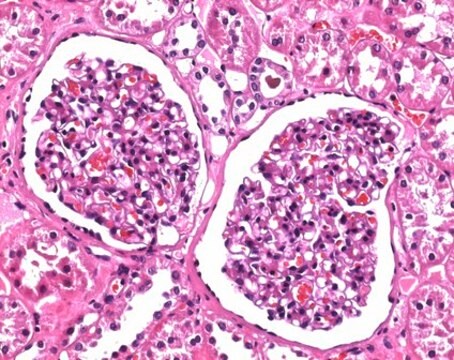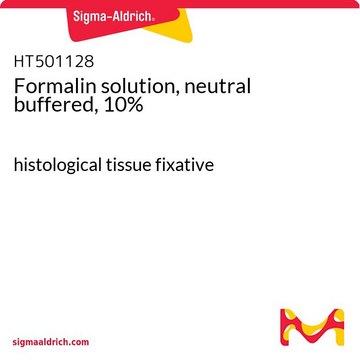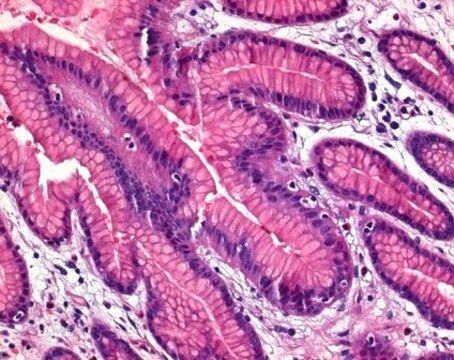47608
Formaldehyde solution
for molecular biology, BioReagent, ≥36.0% in H2O (T)
Synonym(s):
Formic aldehyde, Formol, Formalin
About This Item
Recommended Products
grade
for molecular biology
Quality Level
vapor density
1.03 (vs air)
vapor pressure
52 mmHg ( 37 °C)
product line
BioReagent
form
liquid
autoignition temp.
572 °F
contains
~10% methanol as stabilizer
concentration
≥36.0% in H2O (T)
36.0-38.0% (aldehyde method)
technique(s)
electrophoresis: suitable
impurities
≤0.03% free acid (as HCOOH)
ign. residue
≤0.05% (as SO4)
pH
2.8-4.0
density
1.09 g/mL at 20 °C
1.09 g/mL at 25 °C (lit.)
anion traces
chloride (Cl-): ≤10 mg/kg
sulfate (SO42-): ≤20 mg/kg
cation traces
Ca: ≤5 mg/kg
Cd: ≤1 mg/kg
Co: ≤1 mg/kg
Cr: ≤1 mg/kg
Cu: ≤1 mg/kg
Fe: ≤1 mg/kg
K: ≤20 mg/kg
Mg: ≤1 mg/kg
Mn: ≤1 mg/kg
Na: ≤100 mg/kg
Ni: ≤1 mg/kg
Pb: ≤1 mg/kg
Zn: ≤1 mg/mL
λ
2 M in H2O
UV absorption
λ: 260 nm Amax: 0.01
λ: 280 nm Amax: 0.01
suitability
in accordance for electrophoresis of RNA in agarose gels
storage temp.
room temp
SMILES string
[H]C([H])=O
InChI
1S/CH2O/c1-2/h1H2
InChI key
WSFSSNUMVMOOMR-UHFFFAOYSA-N
Looking for similar products? Visit Product Comparison Guide
General description
It is an aliphatic aldehyde that is widely used in industrial applications for the synthesis of several chemicals such as melamine formaldehyde, urea-formaldehyde, phenol formaldehyde and industrial resins, paraformaldehyde, polyols, chelating agents, slow release fertilizers, 1,4-butanediol and hexamethylenetetramine.
Application
- denaturation and separation of RNA molecules
- anti-bacterial treatment
- fixation of cells
- in the fixation of human spermatogonial stem cell transplantation (SSCT).
- to crosslink T- cell acute lymphoblastic leukemia protein/DNA complex during chromatin immunoprecipitation.
- in fixing zebra fish larvae for neutrophil staining.
Caution
Principle
Not finding the right product?
Try our Product Selector Tool.
Signal Word
Danger
Hazard Statements
Precautionary Statements
Hazard Classifications
Acute Tox. 2 Inhalation - Acute Tox. 3 Dermal - Acute Tox. 3 Oral - Carc. 1B - Eye Dam. 1 - Flam. Liq. 3 - Muta. 2 - Skin Corr. 1B - Skin Sens. 1 - STOT SE 1 - STOT SE 3
Target Organs
Eyes,Central nervous system, Respiratory system
Storage Class Code
3 - Flammable liquids
WGK
WGK 3
Flash Point(F)
133.0 °F - closed cup
Flash Point(C)
56.11 °C - closed cup
Personal Protective Equipment
Choose from one of the most recent versions:
Already Own This Product?
Find documentation for the products that you have recently purchased in the Document Library.
Customers Also Viewed
Articles
Organoid culture products to generate tissue and stem cell derived 3D brain, intestinal, gut, lung and cancer tumor organoid models.
Our team of scientists has experience in all areas of research including Life Science, Material Science, Chemical Synthesis, Chromatography, Analytical and many others.
Contact Technical Service










